Substrate for water heated floors: types, features of choice, installation rules
Proper installation of a heated floor requires the most efficient use of thermal energy. To increase the efficiency of the heating system, various heat-saving techniques are used.
One of the main aspects is the insulating substrate under the water-heated floor, which redirects heat flows from the water circuit to the final coating. Let's look in detail at the features of each type of thermal insulation damper, the intricacies of choosing and installing bedding material.
The content of the article:
The value of thermal insulation substrate
Insulating material is an intermediate layer between the subfloor and the water pipeline with the coolant. The main purpose of the substrate is to preserve and redirect heat flows upward, that is, to the living area of the room.
In addition to the task of preserving heat, the intermediate layer performs a number of equally important functions:
- Waterproofing. In emergency situations, a waterproof substrate will retain water, protect the lower layers of the underground “pie” and prevent water from leaking to the basement floor. In addition, it will prevent the flow of moisture vapor from the screed to the finishing floor covering.
- Thermal insulation. The layer acts as a kind of barrier between elements with different temperatures. Otherwise, contact with a cold floor will contribute to condensation and a decrease in the characteristic qualities of the insulation.
- Uniform heat distribution. The substrate minimizes the likelihood of obvious temperature changes - there are no excessively warm or cold zones.This feature reduces the negative thermal impact on the final flooring, appliances and furniture.
- Sound barrier. Most underlay materials absorb noise from walking on the floor and improve the overall sound insulation of the room.
The substrate softens shock loads on the base, distributing point pressure - this helps maintain the integrity of the screed.

At arrangement of a water floor, the substrate is usually laid on top of the insulation to maximize heat retention - a “thermos effect” is realized, reducing heat loss.

Requirements for bedding material
The characteristics of the substrate are selected depending on the type of roughing base, finishing coating and operational features of the water floor. However, there is a basic list of properties that any type of bedding material must meet.
Strength and elasticity. As a rule, the heating circuit is embedded in a cement-sand screed. The water system pipes, especially those made of metal.
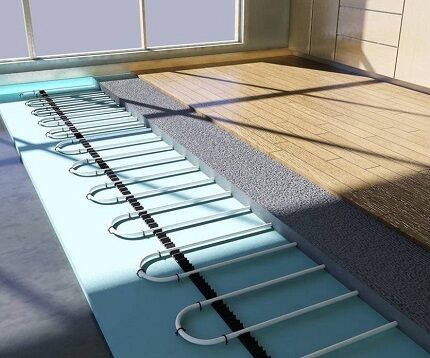
Low thermal conductivity. It is optimal if the heat capacity of the material is combined with its insignificant thickness. The water floor system reduces the height of the room; depending on the type of substrate, the size of the “pie” can be 5-15 cm.
A positive effect is provided by the ability of the substrate to reflect heat, which ensures the presence of a foil film with reflective properties.
High waterproofing properties. An important characteristic is the percentage of maximum water absorption. The material should not absorb or transmit moisture.
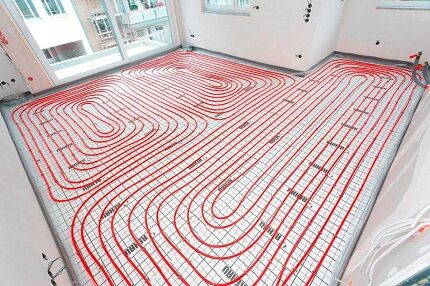
Resistance to temperature changes. The declared properties of the substrate must be maintained at different temperature conditions. When choosing, it is important to evaluate such an indicator as permissible operating temperatures. The limit value is not less than +70°C.
In addition to the stated requirements, the substrate should not emit toxic or harmful substances. A definite plus is the low price and ease of installation.
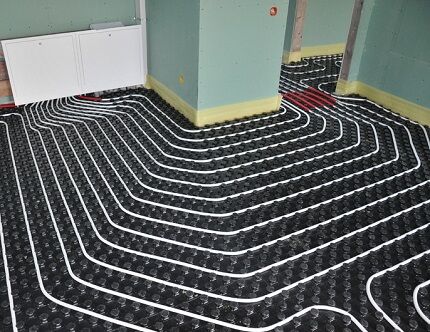
Types of substrates: assessment of properties and characteristics
Various thermal insulation materials meet the listed requirements to varying degrees. Slab polystyrene is closer to the ideal than others.However, in some situations it is reasonable to use alternative options: foil polyethylene foam, cork backing or moisture-resistant chipboard.
Expanded polystyrene boards - a universal solution
Expanded polystyrene is the result of industrial foaming of polystyrene. The finished product contains 2% of the main component with auxiliary additives and 98% of gas. The air is enclosed in hermetically sealed cells, which allows the material to maintain temperature well.
The thermal conductivity of polystyrene foam 10 cm thick is equivalent to a layer of wood of 0.35 m, reinforced concrete and brick walls - 4.8 m and 1.5 m, respectively.
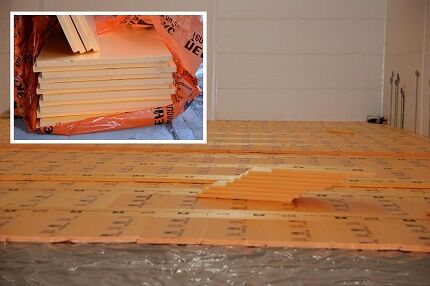
Technical and operational characteristics of polystyrene foam:
- Thermal conductivity is 0.028-0.034 W/m*K. The value of the indicator is directly proportional to the density of the insulation.
- Water permeability varies between 0.019-0.015 mg/m*h*Pa. The extruded material is formed by squeezing the polymer melt through a slot-shaped nozzle.
- Moisture absorption dense polystyrene foam is 0.4%, which is 10 times less compared to conventional polystyrene foam. The thermal conductivity of the substrate is maintained even with constant exposure to moisture.
Strength extruded polystyrene for compression at a linear deformation of 10% is 0.25-0.50 MPa, depending on the grade of material.
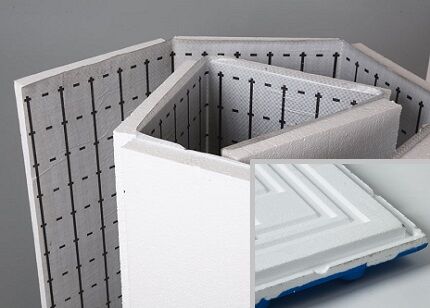
Weaknesses of expanded polystyrene: relatively low soundproofing ability and flammability. The substrate is afraid of solvents, acetone, turpentine and kerosene - under their influence the material is deformed.
For thermal insulation, you should not choose unpressed or autoclaved polystyrene foam. These varieties are more fragile.
Extruded or pressed foam plastic mats are suitable as a substrate for a water-heated floor - their thermal conductivity is approximately equal. Popular with consumers Penoplex thermal insulation.
Cork material - environmentally friendly use
Cork lining is made from crushed, compressed pellets of tree bark using various binders. The main argument in favor of such a substrate is naturalness and absolute environmental friendliness. The material is hypoallergenic and harmless to health.
Additional benefits of cork:
- resistance to deformation - after short-term shock loads it returns to its original shape;
- porosity provides high noise-absorbing properties;
- good thermal insulation characteristics;
- ease of cutting and laying.
Cork damper is sold in the form of rolls and individual sheet panels. The products differ in the thickness of the lining: rolled material – 2-4 mm, cork mats – 4-10 mm.
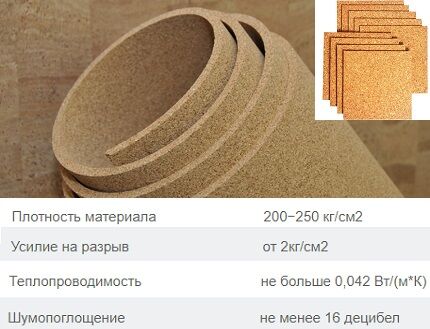
Disadvantages of cork substrate:
- vulnerability to moisture;
- Demanding requirements for waterproofing the subfloor;
- sensitivity to large static loads.
It is better not to use the classic version of cork underlay under a water floor system. For these purposes, a rubber-cork coating is suitable, where rubber acts as a binder. In addition to water resistance, the damper has improved sound and vibration insulation characteristics, but it can no longer be called completely natural.
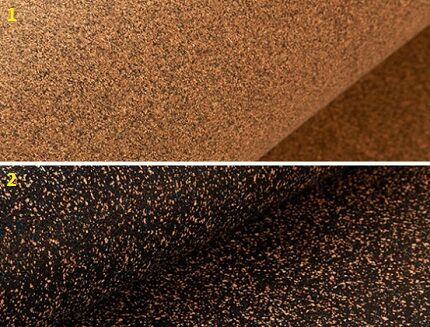
Features of the polyethylene foam damper
The simplest and most affordable solution is a polyethylene foam backing. The material is produced by extrusion of polyethylene granules followed by heat treatment and pressing. The output is an elastic fabric filled with many air pores.
Polyethylene foam substrates, depending on the characteristics of the structure, are classified into two groups: non-crosslinked and crosslinked.
Non-crosslinked polyethylene foam consists of gas-filled cells up to 3 mm in size. The thickness of the substrate ranges from 0.8 to 6 mm, the width of the roll is 1-1.5 m.
The main advantages of such a substrate include:
- high moisture resistance – water absorption no more than 1%;
- small thickness;
- low cost.
However, non-crosslinked polyethylene foam has more disadvantages. The material is short-lived, wears out quickly, is pressed under weight and loses flexibility over time. The thermal conductivity coefficient is 0.55 W/(m°C), which indicates insufficient heat retention.
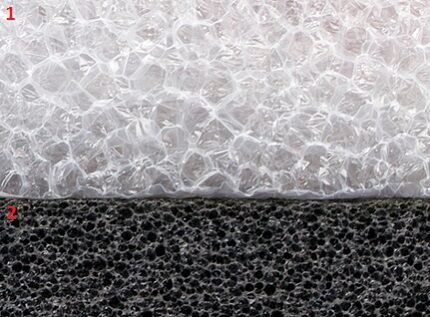
Cross-linked polyethylene foam has the following features:
- phenomenal strength;
- increased density – 33 kg/cub.m, the same indicator for non-crosslinked polyethylene – 25 kg/cub.m;
- high level of noise absorption - up to 18 dB;
- low level of thermal conductivity – 0.031 W/(m°C);
- release format in rolls and mats, the thickness of the finished product is 1-20 mm.
The service life of the substrate reaches 15 years.

Thermal reflective metallized substrates
Foil substrates are widely used. Moreover, various materials can be used as a base: slab extruded polystyrene foam, its non-extruded counterpart foam, cork material or polyethylene foam.
In each case, the metallized film improves the original technical characteristics of the base and complements it with reflex qualities.
The reflective outer covering is made of aluminum and lavsan. The thickness of the foil layer determines the degree of heat reflection of the insulation.
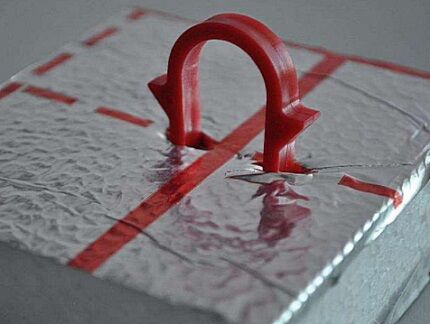
Lavsan is resistant to aggressive environments - the material retains its reflectivity and functions as a water barrier during prolonged contact with a concrete screed.
Worthy representatives of a heat-reflecting substrate based on polyethylene foam: Penofol, Isoflex, Ecofol. Foil insulation based on polystyrene foam – SunPol.
OSB and chipboard - “dry” laying technology
Wood-based materials act as a substrate when installing heated floors using Finnish technology. The method allows you to abandon the need for a monolithic concrete screed.
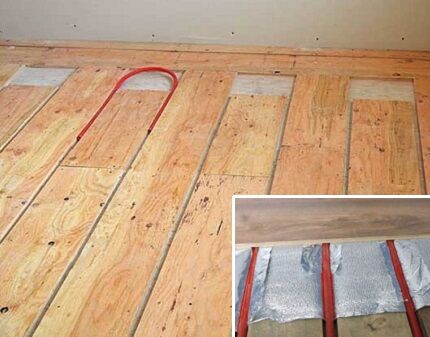
A floor on a wooden base has a number of features:
- ease of assembly;
- high strength characteristics;
- environmental Safety;
- versatility - suitable for finishing with various floor coverings.
The weak side of the wood-based substrate is its susceptibility to moisture. To increase the hydro- and thermal insulation properties between the pipes and the wooden base, it is recommended to lay a thin backing, the best option is foil-coated polyethylene.
Selecting a substrate by type of base
The physical characteristics of the decorative floor covering significantly influence the choice of linear parameters and physical qualities of the substrate. The greater the weight of the finish, the stronger and more reliable the damper should be.
Ceramic tile. Water tiled floor is arranged using concrete technology - the contour is mounted under a monolithic screed. This method involves significant loads on the lining material.
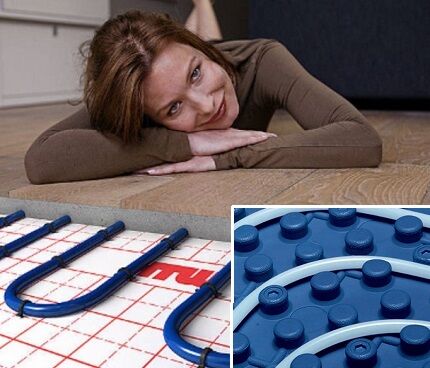
Laminate. The main criterion for choosing a substrate for a warm water floor with a laminate coating is the highest possible heat saving rate, since the panels themselves do not transmit heat well.
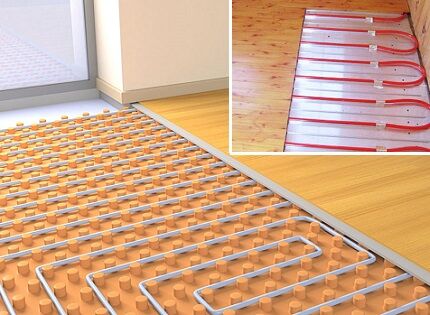
The optimal solution is heat-reflecting insulation with a low degree of thermal conductivity.
Linoleum. Installation of roll coating is carried out on plasterboard, OSB or sheet plywood. The panels have an impressive weight, which means that the requirements for the strength of the substrate are becoming more stringent. It is recommended to give preference to polystyrene foam, cork options or a lining made of cross-linked polyethylene foam.
More information about the installation of a water-heated floor under linoleum is written in this article.
Laying technology: a set of basic rules
Installing the substrate is not difficult; you can do the work yourself. The main thing is to follow simple and clear rules.
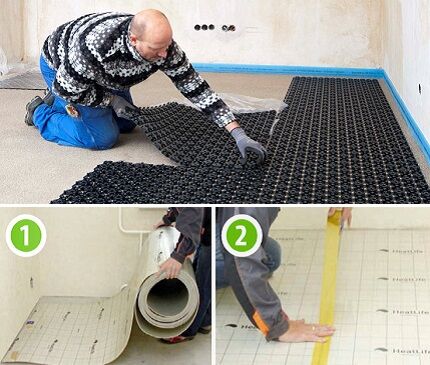
General requirements for installation of the substrate:
- Exact calculation. It is necessary to determine in advance the amount of material taking into account the standard sizes of the lining. It is optimal if the insulation is placed with a minimum number of joints.
- Preparing the subfloor. The base must be level. You shouldn’t rely too much on the ability of dense material to mask unevenness - any product will take the shape of the base over time.
- Waterproofing. Substrates made from natural components (cork, chipboard, OSB) require preliminary installation of a water barrier. It is enough to lay thick polyethylene.
- Laying. Rolled, sheet material is rolled out without stretching; overlap onto the walls is required. The slabs are placed close to vertical surfaces, protected by 10 cm of damper tape.
- Docking. Rolled insulation sheets are overlapped and secured together with construction tape. Plates and mats are grouped end to end.
When installing a heated floor under a laminate, it is necessary to take into account the direction of the panels - they are placed mutually perpendicular to the roll backing.
Conclusions and useful video on the topic
When choosing a substrate, it is better to give preference to products from well-known brands. Among the popular brands, both domestic and foreign companies have proven themselves well.
Installation of a heated floor using extruded polystyrene foam "Penoplex":
Placement of Izolon-500 polyethylene foam underlay under a floating heated floor:
General recommendations for choosing insulation for laying a water circuit:
The importance of insulating underfloor heating is difficult to overestimate. The efficiency and profitability of the heating system largely depends on its quality, as well as its compliance with the floor covering and the technology for placing the “water coil”.
Are you looking for a substrate for a water-heated floor? Or do you have experience installing and using a certain type of thermal insulation mat? Please leave comments on the article, ask questions and participate in discussions. The contact form is located below.




I used extruded polystyrene foam marked 35 to install my heated floor. It has a large margin of compressive strength. The higher the class, the more expensive, but what's the point of throwing away extra money?
As for flammability and its other “disadvantages” mentioned here, this is not about a heated floor, because the whole cake is in the screed, and there it is not threatened by either fire or solvents.
Many generally make do with non-crosslinked polyethylene foam, which has a high moisture resistance and low cost. The combination of these two qualities makes this material popular for use as a substrate for water-heated floors. But it’s better to add a little money and take cross-linked polyethylene foam, which has a higher strength rating.
In your case, using extruded polystyrene foam marked 35 as a substrate is a completely practical solution. You don’t have to worry about the flammability of the material; there will simply be nothing to burn under the screed due to the lack of oxygen. But this material, relative to cross-linked polyethylene foam, has a very low noise insulation rate. So keep that in mind.